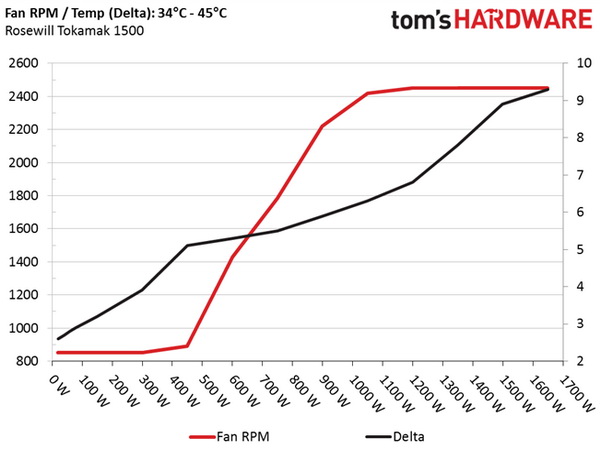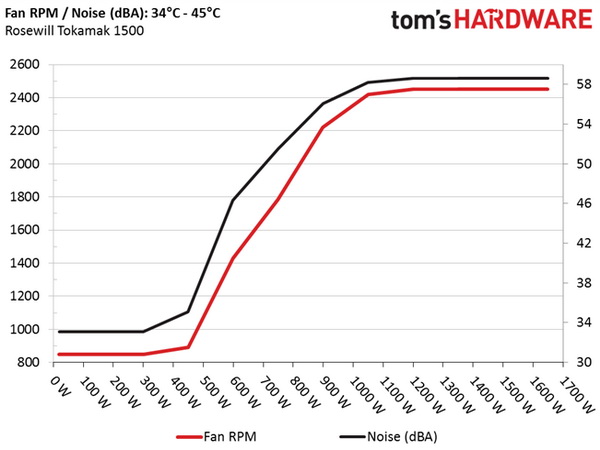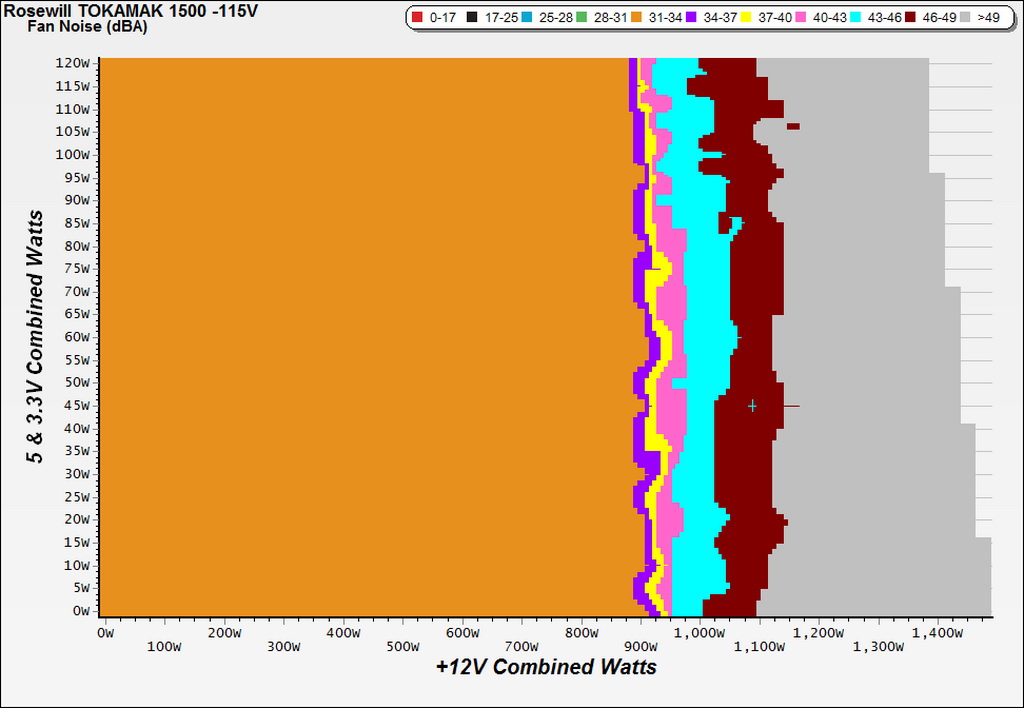Rosewill Tokamak 1500 PSU Review
Rosewill enters the 80 PLUS Titanium efficiency club with two Tokamak models boasting 1.2kW and 1.5kW of capacity. The highest-end version is on our bench today, and we're eager to check out its Enhance-based platform.
Why you can trust Tom's Hardware
Efficiency, Temperature, And Noise
Efficiency
Our efficiency testing procedure is detailed here.
Using results from the previous page, we plotted a chart showing the Tokamak 1500's efficiency at low loads, and loads from 10 to 110 percent of its maximum-rated capacity.
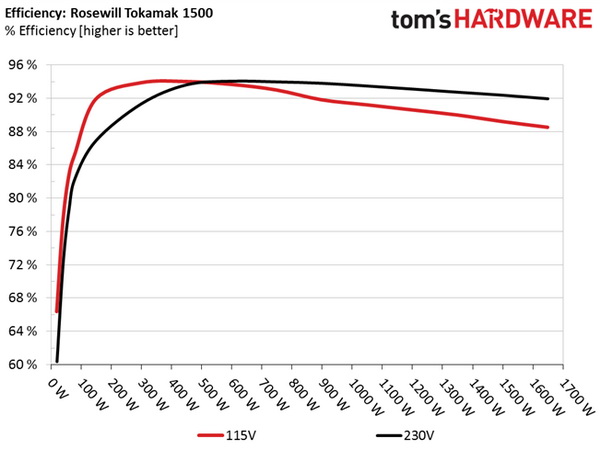
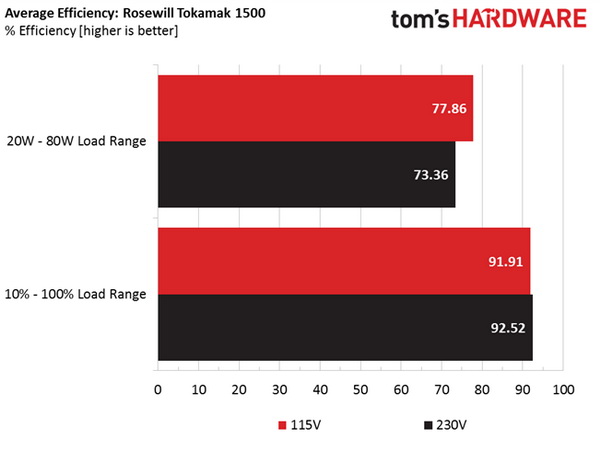
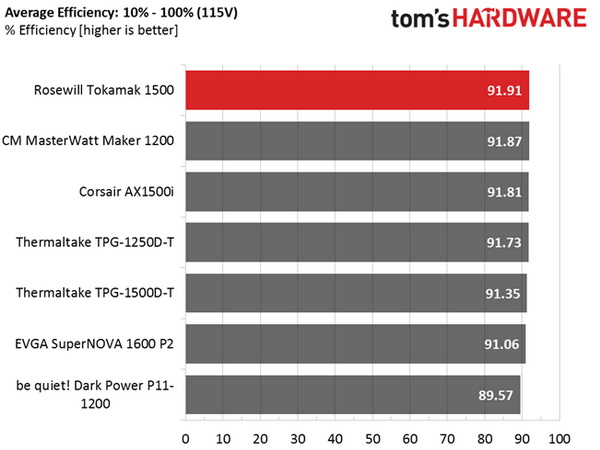
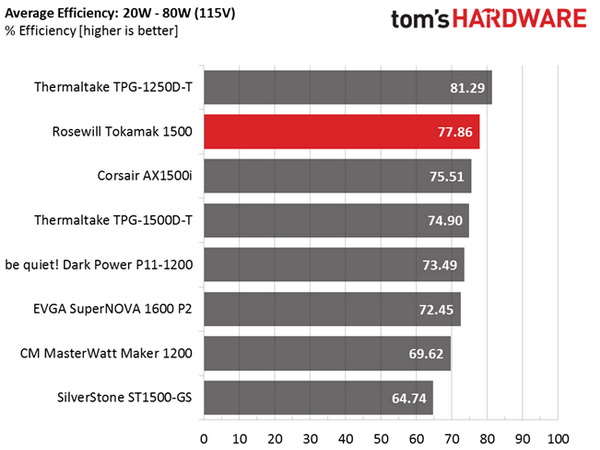
Efficiency-wise, this platform performs well, taking over the top spot under normal loads and scoring second place under light ones.
Efficiency At Low Loads
In the following tests, we measure the Tokamak 1500's efficiency under loads significantly lower than 10 percent of its maximum capacity (the lowest load the 80 PLUS standard measures). The loads we dialed were 20, 40, 60, and 80W. This is important for representing when a PC is idle, with power-saving features turned on.
| Test # | 12V | 5V | 3.3V | 5VSB | DC/AC (Watts) | Efficiency | Fan Speed | Fan Noise | PF/AC Volts |
|---|---|---|---|---|---|---|---|---|---|
| 1 | 1.205A | 0.489A | 0.475A | 0.195A | 19.68 | 66.40% | 850 RPM | 33.1 dB(A) | 0.743 |
| 12.136V | 5.052V | 3.368V | 5.045V | 29.64 | 115.0V | ||||
| 2 | 2.432A | 0.980A | 0.979A | 0.397A | 39.76 | 77.04% | 850 RPM | 33.1 dB(A) | 0.844 |
| 12.133V | 5.052V | 3.368V | 5.040V | 51.61 | 115.0V | ||||
| 3 | 3.662A | 1.475A | 1.483A | 5.036A | 59.87 | 82.72% | 850 RPM | 33.1 dB(A) | 0.886 |
| 12.131V | 5.052V | 3.368V | 5.036V | 72.38 | 115.0V | ||||
| 4 | 4.883A | 1.977A | 1.958A | 0.795A | 79.80 | 85.29% | 850 RPM | 33.1 dB(A) | 0.907 |
| 12.129V | 5.050V | 3.368V | 5.030V | 93.56 | 115.0V |
We would like to see a >70% reading with 20W load, but we're getting picky there since this is a 1.5kW unit and 20W is only 1.3% of its rated capacity. The main problem we have is with fan noise, which could be a lot less intrusive if Rosewill used a lower minimum or implemented a semi-passive mode.
5VSB Efficiency
The ATX specification states that 5VSB standby supply efficiency should be as high as possible, recommending 50 percent or higher efficiency with 100mA of load, 60 percent or higher with 250mA of load, and 70 percent or higher with 1A or more of load.
We take four measurements: one each at 100, 250, and 1000mA, and one with the full load the 5VSB rail can handle.
Get Tom's Hardware's best news and in-depth reviews, straight to your inbox.
| Test # | 5VSB | DC/AC (Watts) | Efficiency | PF/AC Volts |
|---|---|---|---|---|
| 1 | 0.102A | 0.50 | 70.42% | 0.030 |
| 4.948V | 0.71 | 115.1V | ||
| 2 | 0.252A | 1.25 | 77.16% | 0.068 |
| 4.942V | 1.62 | 115.1V | ||
| 3 | 1.002A | 4.93 | 83.28% | 0.217 |
| 4.925V | 5.92 | 115.1V | ||
| 4 | 3.002A | 14.62 | 82.14% | 0.415 |
| 4.869V | 17.80 | 115.1V |
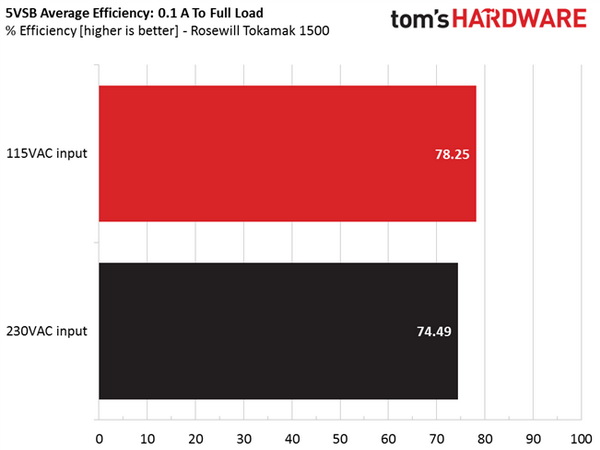

The 5VSB rail is highly efficient, as you can see in the table and graphs above. Only Thermaltake's TPG-1250D-T achieves an overall higher 5VSB efficiency score.
Power Consumption In Idle And Standby
In the table below, you'll find the power consumption and voltage values of all rails (except -12V) when the PSU is idle (powered on, but without any load on its rails), and the power consumption when the PSU is in standby mode (without any load, at 5VSB).
| Mode | 12V | 5V | 3.3V | 5VSB | Watts | PF/AC Volts |
|---|---|---|---|---|---|---|
| Idle | 12.135V | 5.054V | 3.369V | 5.053V | 8.62 | 0.335 |
| 115.1V | ||||||
| Standby | 0.07 | 0.003 | ||||
| 115.1V |
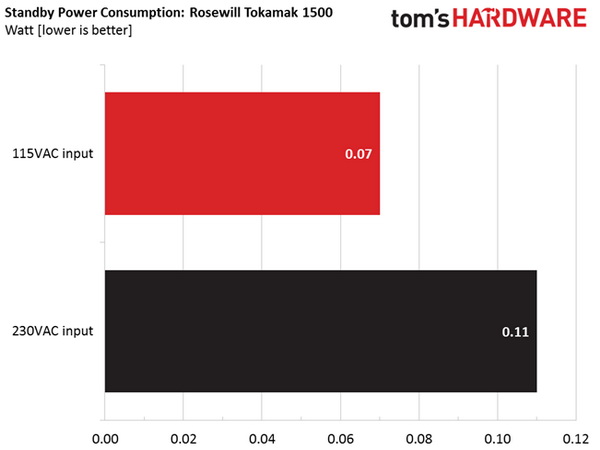
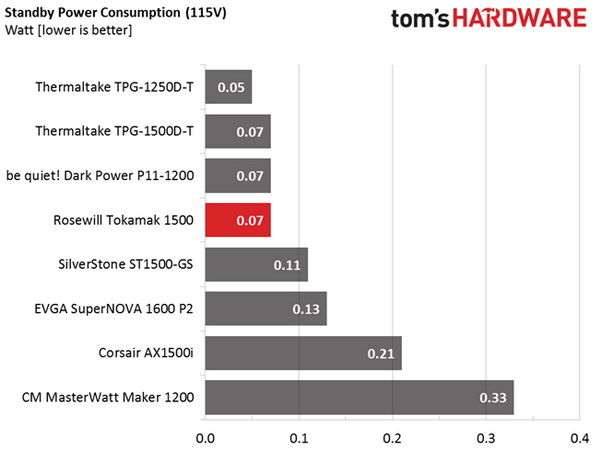
Standby power consumption is very low, giving Rosewill a big advantage.
Fan RPM, Delta Temperature, And Output Noise
Our mixed noise testing is described in detail here.
The first chart below illustrates the cooling fan's speed (in RPM), and the delta between input and output temperature. The results were obtained at 34°C (93.2°F) to 45°C (113°F) ambient temperature.
The next chart shows the cooling fan's speed (again, in RPM) and output noise. We measured acoustics from one meter away, inside a small, custom-made anechoic chamber with internals completely covered in sound-proofing material (be quiet! Noise Absorber kit). Background noise inside the chamber was below 18 dB(A) during testing, and the results were obtained with the PSU operating at 34°C (93.2°F) to 45°C (113°F) ambient temperature.
The following graph illustrates the fan's output noise over the PSU's operating range. The same conditions of the above graph apply to our measurements, though the ambient temperature was between at 28°C (82.4°F) to 30°C (86°F).
This is a noisy PSU, no doubt about that. With more than 1.1kW of load you're going to want earplugs. Given our high efficiency measurements, Rosewill could stifle some of the noise by using a more relaxed fan profile. Fortunately, up to around 900W in normal ambient conditions, the fan's noise is low enough in the 31-34 dB(A) region.
Current page: Efficiency, Temperature, And Noise
Prev Page Load Regulation, Hold-Up Time, And Inrush Current Next Page Protection Features, Evaluated
Aris Mpitziopoulos is a contributing editor at Tom's Hardware, covering PSUs.
-
Onus With GPU-based mining days long gone, I don't ever see myself in the market for a beast like this; but no power switch? That's...bizarre.Reply -
Brian_R170 I keep reading that muti-GPU systems are on the decline, so what's continuing to drive development of PSUs with >1KW output?Reply -
kittle Reply
Im curious too -- i can only speculate the marketing folks are still pushing the "bigger number == better" mantra18972155 said:I keep reading that muti-GPU systems are on the decline, so what's continuing to drive development of PSUs with >1KW output? -
JohnnyLucky There are still some hardcore enthusiasts and a few who want bragging rights. I couldn't help but notice quite a few cons.Reply -
captaincharisma there is always someone out there whether they are an enthusiast or a first time system builder that will blindly buy this because after all "bigger is better" lolReply -
turkey3_scratch Rosewill always goes with a very simple exterior. I like it. This is also a very unique name. I'm sick of boring PSU names. Tomakamek. Sounds like some sort of ancient island, I like it.Reply -
SkyBill40 The reactor of the same name was the first thing that came to mind upon seeing it and even before it was mentioned in the write up. An interesting choice, no doubt. Given the output, I guess it's somewhat fitting.Reply -
daglesj Must admit rarely use the power switch at the back. Quicker to know that a pulled power lead means 'off'...completely. No great loss.Reply -
lunyone So ready for this to be in a m-ITX build! Lol! Too bad it isn't modular! <sarcasm over>Reply
